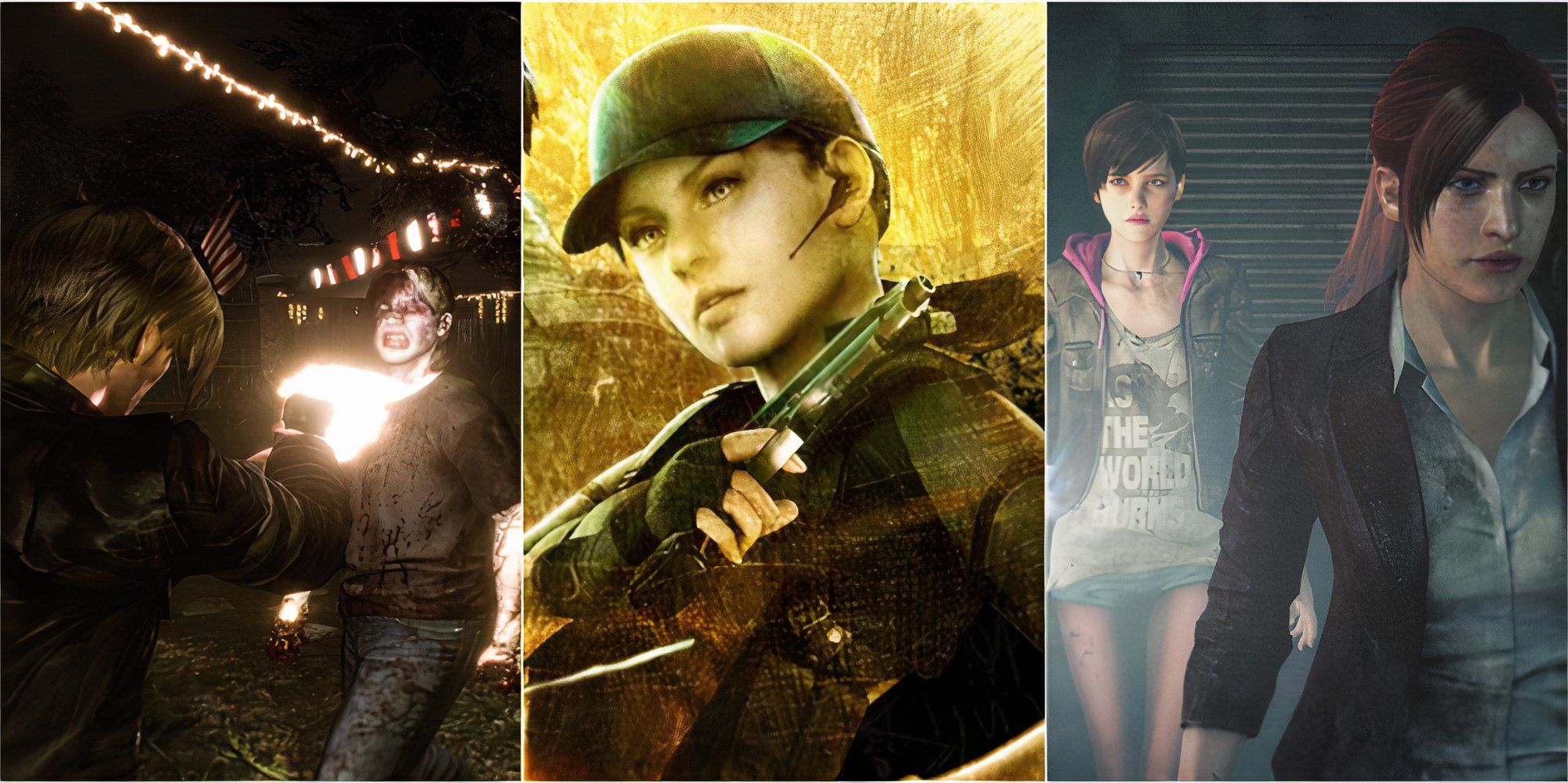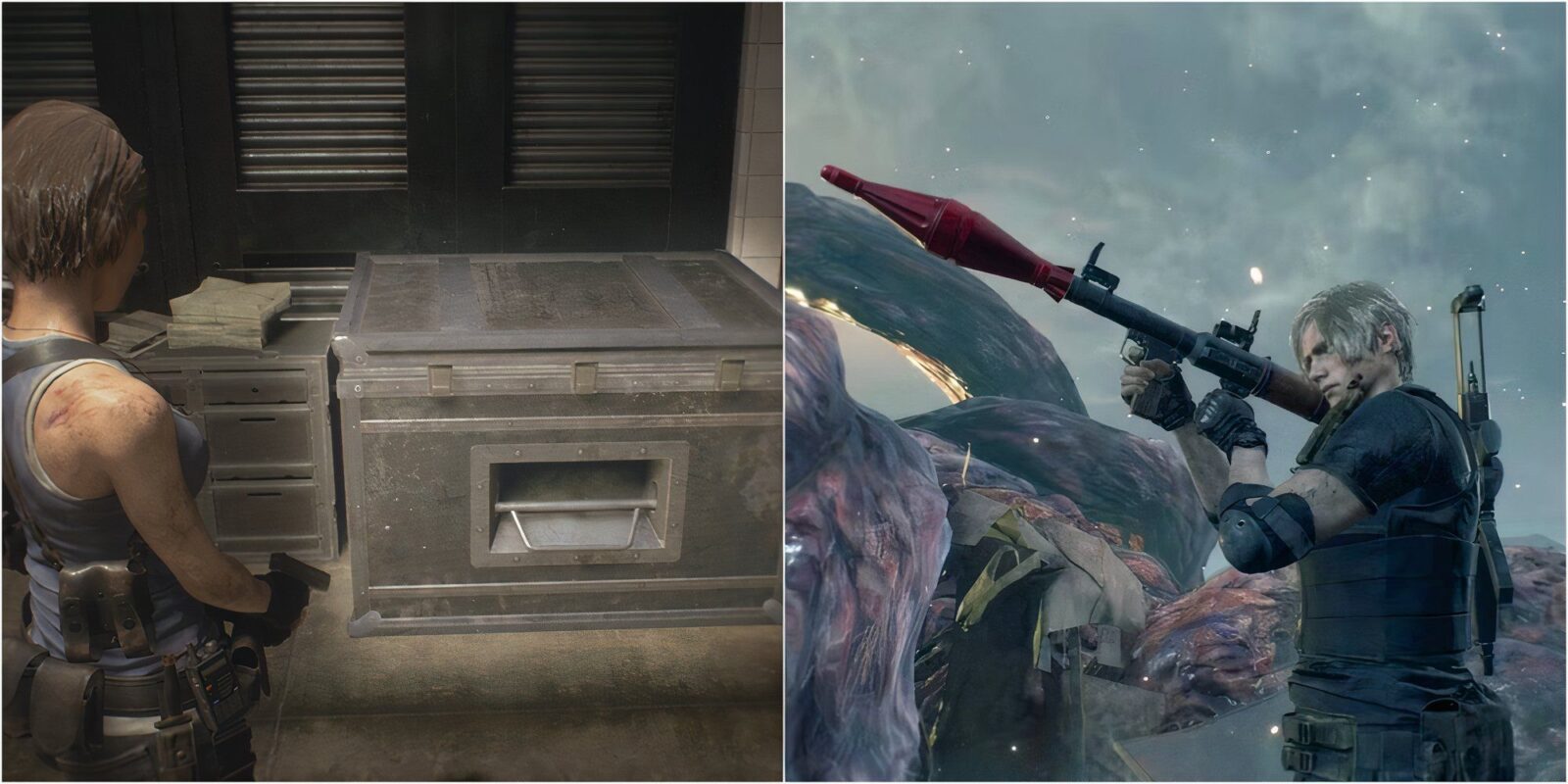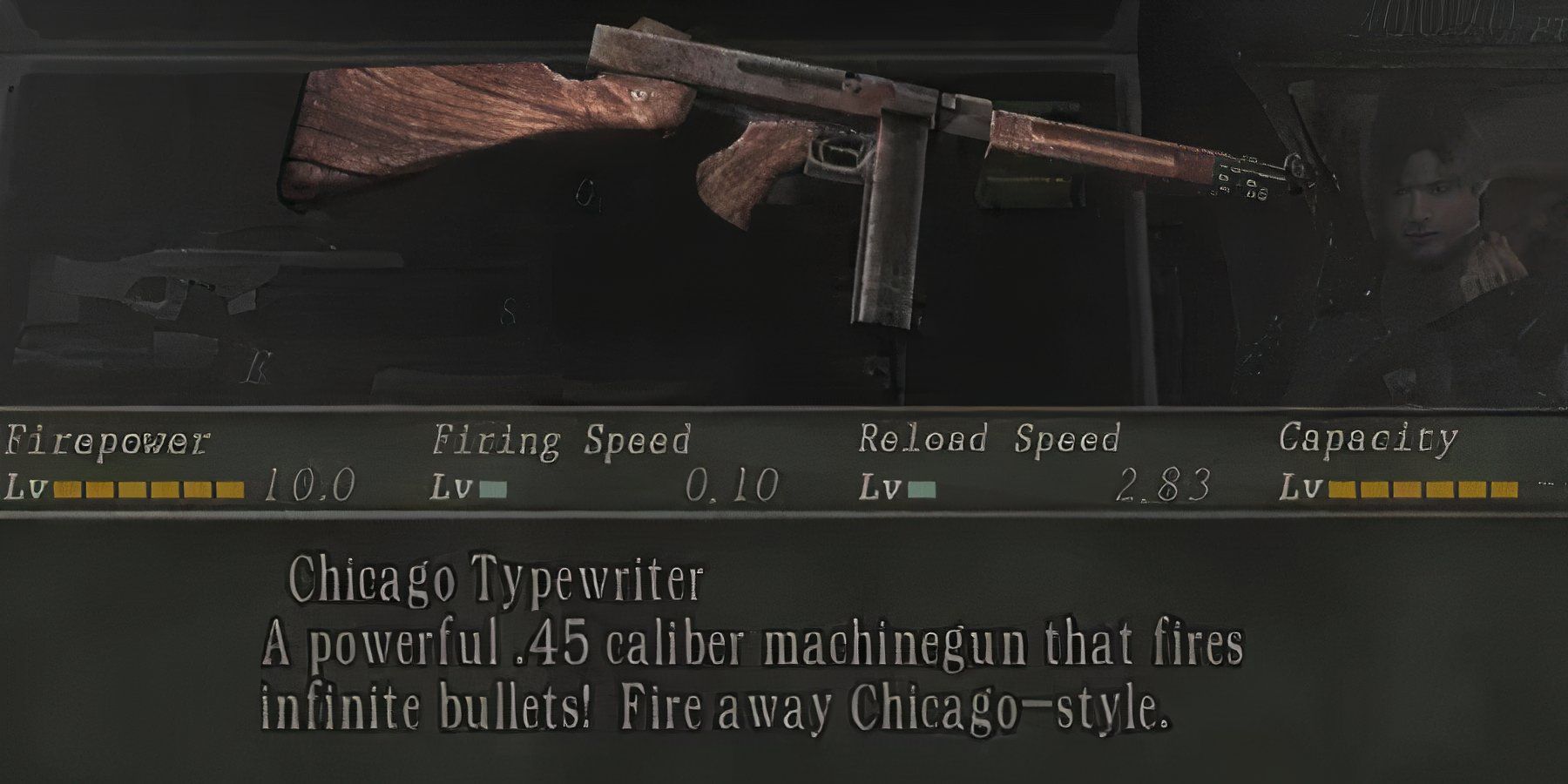Summary
- Typewriters serve as iconic save points, often appearing in other games as a nod to the series.
- Modern “horde sections” thrust players into chaotic situations, testing their skills and reflexes.
- Labs make traditional appearances, playing a key role in unraveling the story’s mysteries.
The Resident Evil franchise has gone through many changes throughout the series. Whether it’s the change in camera perspective, the switch from zombies to more humanoid enemies, or even simply the sudden turns in the wider narrative, it’s fair to say no game is alike, though there is still a glue that keeps all of these titles within the same franchise, and that’s the traditions they carry.

Related
7 Resident Evil Games With The Best Atmosphere, Ranked
The Resident Evil franchise has built a reputation for using dark atmospheres to facilitate horror, and these games exemplify that philosophy.
Since the very first Resident Evil back in 1996, there have been several features, mechanics, and general quirks that have been implemented in almost every game in the series. Even in the more modernized games, which are often seen as soft reboots of the series, these specific traditions always manage to appear, since at the end of the day, they are at the core of what makes these games Resident Evil.
1 Typewriters
Save Points That Have Become Iconic Iconography Within The Resident Evil Franchise
The typewriter has always been the quintessential save point in nearly all the Resident Evil games. Sometimes, the player simply needs to click on them and will be gifted an automatic save, but for harder difficulties, and in the classic games, an ink ribbon will be needed for players to record their data.
They have become such a staple that any time a typewriter shows up in another survival horror game, it almost feels like they have to be an homage to the franchise that kicked off the entire subgenre. Alternatively, players might approach a typewriter in other games to save just out of habit, as was the case for many in the Silent Hill 2 Remake.
2 Horde Section
A Brutal Horde Section Thrusts Players Straight Into The Nightmare That Awaits Them
This is more of a modern staple in the series that Capcom seems to try and fit into each new game, so long as it doesn’t feel too out of place. It all started with the original Resident Evil 4 where players are forced to survive an onslaught of enemies in the village during the very first hour of the game. This was then replicated in Resident Evil 5 with the public assembly, and later in the Village, where Ethan must try to fend off a horde of Lycans for a specific amount of time before the sequence ends.
These “horde sections” are a way to make players feel as though they’ve truly been thrust into the middle of a nightmare, while also forcing them to become familiar with the controls right from the get-go. They might not appear in every game, but these early scenarios have popped up in enough of the more recent titles to be considered a tradition.
3 Laboratories
A Lab Will Always Make An Appearance, Even If It Makes No Geographical Sense
It doesn’t matter if the game is set in an urban city, a training facility, or even a rural estate out in the middle of nowhere, it can’t be a Resident Evil title without a lab showing up. Very often, players will need to navigate their way through a laboratory near the end of the game to find out first-hand how the B.O.Ws were made, while also uncovering files concerning the malicious individuals who were behind their creation.

Related
Resident Evil: 8 Best Aquatic Monsters, Ranked
These Resident Evil monsters prefer to hide away underwater before jumping out to catch their prey unexpectedly.
This was a tradition that started back in the first game and has managed to show up in almost every game going forward, no matter how out of place they might feel. A prime example of this can be seen in Resident Evil 7 where a lab can be found buried in the salt mines, purely to serve the plot.
4 Herbs
The Go-To Healing Items Have Become A Staple Of The Series
Most players were probably pretty confused when stumbling across an herb in their first Resident Evil game, but after a while, it becomes difficult to not see them as the go-to healing item of the series. Rather than a syringe or medical kit, Capcom decided to get a little more creative and make the primary healing items in the games plant herbs, which come in a range of colors.
While green herbs are the most recognizable and can instantly heal the character’s health, combining them with a red herb can bolster their healing properties, while yellow herbs will extend the protagonist’s maximum health. There are a few other herbs that have been introduced throughout the series, with them quickly becoming a mainstay that has made an appearance in every game, including the spin-offs.
5 Item Boxes
Even to this very day, the fact Resident Evil 0 decided to do away with item boxes entirely is still an annoyance for many players, and the reason is because of how crucial they are to the core gameplay formula. These large containers can be found in most safe rooms and will allow players to store any items for later that they can’t currently carry, making them extremely useful, especially when planning out a route to the next area.
Though it admittedly doesn’t make much sense how these boxes randomly teleport items between one another, considering they are the only way to drop off items in the older games, it doesn’t matter all too much. Capcom has left the item boxes out of a few of the modern games, such as Village and Resident Evil 5 and 6, but the fact they returned in Resident Evil 7 shows they are far from forgotten.
6 So Many Locked Doors
It Seems No Building In Resident Evil Can Exist Without At Least Half The Doors Being Locked
In the first Resident Evil game, it at least sort of makes sense why the whole Spencer Mansion is full of locked doors, booby traps, and absurd puzzles given it was designed that way by George Trevor. This trend continued in the second game though, where the R.P.D. had several doors that could only be unlocked by seeking out bizarre keys and rare items that seemed to have been purposefully placed around the station by someone who simply wanted to make things harder for the player.

Related
Resident Evil: 8 Characters Who Survived The Raccoon City Incident
Out of the thousands of people who perished in the Raccoon City incident, these Resident Evil characters managed to make it out in one piece.
Then again, considering a big part of Resident Evil games is entering a new area and slowly progressing through it little by little, having this sort of gameplay formula does ensure players don’t just sprint through as fast as humanly possible. As Ethan notes in Resident Evil 7, it’s pretty strange anyone would ever decide to live or reside in buildings where at least half the doors are locked at all times.
7 Cheesy Dialogue
B-Movie Horror Dialogue Has Always Brought A Lot Of Charm To The Series
When the first Resident Evil game was released back in the late 90s, it was presented as sort of like a B-horror movie that was trying to be a little tongue-in-cheek, rather than being deadly serious in tone. As a result, the dialogue was pretty cheesy at times, with popular examples being the mention of the “Jill sandwich” and the “Master of lockpicking.”
This ended up adding a lot of charm to the game and would be a trend carried over into future titles, really reaching its peak in the fourth entry where Leon comes out with all kinds of weird and whacky lines. Even in the remake of that game where Capcom tried to take a more grounded approach to the story, there are still lines like “Nighty night, knights” and “I was almost a pancake” to ensure fans that this tradition was still very much intact.
8 Infinite Ammo
A Rewarding Bonus That Makes Subsequent Playthroughs So Much Easier
It’s always nice to earn a few extra goodies after completing a single-player game to try out on a second playthrough, and in the case of Resident Evil, this takes the form of infinite ammo. Ever since the original Resident Evil 2, which introduced the rocket launcher and gatling guns as usable weapons, nearly all the mainline games have included infinite ammo weapons that can be used to make a subsequent playthrough much easier.
Alternatively, games like Resident Evil 5 will allow players to equip infinite ammo to any weapon they enjoy using by unlocking it with special bonus points. Completing the game is obviously the main priority when first booting up a new Resident Evil game, but getting infinite ammo is always the second most sought-after thing most players will strive toward.
9 The Rocket Launcher
The Final Saving Grace That Saves The Day Every Single Time
Every time the player gets to the very end of a Resident Evil game, they are expected to use up every last bullet they’ve stashed away to wear down the final boss, before being handed a one-hit-kill rocket launcher to finish things off. In the first game, it was used to blow the Tyrant to smithereens, but as the final bosses became bigger and more durable, the rocket launcher kept coming back as a saving grace.
As a result, it’s always established that the rocket launcher, by default, is the most powerful weapon in each game, which is why obtaining the infinite rocket launcher is such a rewarding prize for the player’s efforts. It was even the weapon used to take down the series’ main villain, Albert Wesker, which just goes to show how devastating it is within the Resident Evil universe.

More
7 Best Resident Evil Games With Little Or No Backtracking
Anyone who is a little put off by the amount of backtracking involved in the original Resident Evil games ought to try these entries.



















Leave a Reply